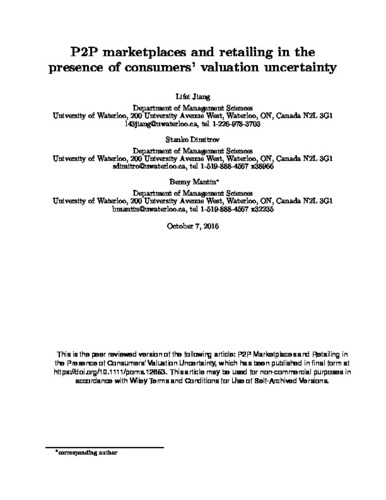| dc.contributor.author | Jiang, Lifei | |
| dc.contributor.author | Dimitrov, Stanko | |
| dc.contributor.author | Mantin, Benny | |
| dc.date.accessioned | 2020-09-09 20:02:23 (GMT) | |
| dc.date.available | 2020-09-09 20:02:23 (GMT) | |
| dc.date.issued | 2017-03 | |
| dc.identifier.uri | https://doi.org/10.1111/poms.12653 | |
| dc.identifier.uri | http://hdl.handle.net/10012/16271 | |
| dc.description | This is the peer reviewed version of the following article: P2P Marketplaces and Retailing in the Presence of Consumers' Valuation Uncertainty, which has been published in final form at https://doi.org/10.1111/poms.12653. This article may be used for non-commercial purposes in accordance with Wiley Terms and Conditions for Use of Self-Archived Versions. | en |
| dc.description.abstract | Can peer‐to‐peer (P2P) marketplaces benefit traditional supply chains when consumers may experience valuation risk? P2P marketplaces can mitigate consumers' risk by allowing them to trade mismatched goods; yet, they also impose a threat to retailers and their suppliers as they compete over consumers. Further, do profit‐maximizing marketplaces always extract the entire consumer surplus from the online trades? Our two‐period model highlights the effects introduced by P2P marketplaces while accounting for the platform's pricing decisions. We prove that with low product unit cost, the P2P marketplace sets its transaction fee to the market clearing price, thereby extracting all of the seller surplus. In this range of product unit cost, the supply chain partners are worse off due to the emergence of a P2P marketplace. However, when the unit cost is high, the platform sets its transaction fee to be less than the market clearing price, intentionally leaving money on the table, as a mechanism to stimulate first period demand for new goods in expectation for some of them to be traded later, in the second period, via the marketplace. It is not until the surplus left with the sellers is sufficiently high that the supply chain partners manage to extract some of this surplus, ultimately making them better off due to a P2P marketplace. We further analyze the impact of a P2P marketplace on consumer surplus and social welfare. In addition, we consider model variants accounting for a frictionless platform and consumer strategic waiting. | en |
| dc.description.sponsorship | Natural Sciences and Engineering Research Council of Canada, Jean‐Jacques Laffont Digital Chair on Digital Economy at TSE, IAST | en |
| dc.language.iso | en | en |
| dc.publisher | Wiley | en |
| dc.subject | consumers' valuation risk | en |
| dc.subject | P2P marketplace | en |
| dc.subject | retailing strategy | en |
| dc.subject | backward induction | en |
| dc.title | P2P Marketplaces and Retailing in the Presence of Consumers' Valuation Uncertainty | en |
| dc.type | Article | en |
| dcterms.bibliographicCitation | Jiang, Lifei, Stanko Dimitrov, and Benny Mantin. “P2P Marketplaces and Retailing in the Presence of Consumers’ Valuation Uncertainty.” Production and Operations Management 26, no. 3 (2017): 509–24. https://doi.org/10.1111/poms.12653. | en |
| uws.contributor.affiliation1 | Faculty of Engineering | en |
| uws.contributor.affiliation2 | Management Sciences | en |
| uws.typeOfResource | Text | en |
| uws.peerReviewStatus | Reviewed | en |
| uws.scholarLevel | Faculty | en |
| uws.scholarLevel | Graduate | en |

